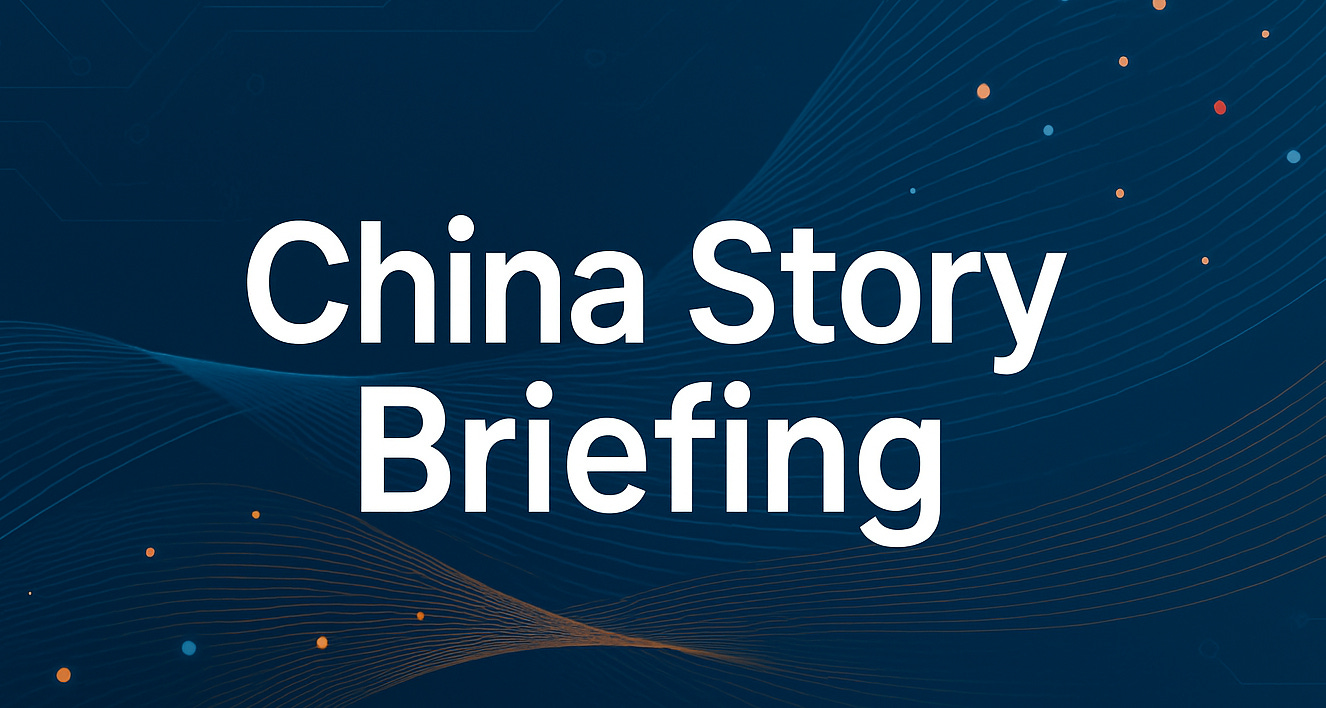China Story Briefing|Manus CTO: How "Context Engineering" Makes AI Agents Learn From Failure
Core theme + counterintuitive wisdom (embracing errors).
Hi everyone, and welcome to this issue of the China Story Briefing! This week, the Chinese AI community is in the midst of a vibrant "open-source summer," headlined by Moonshot AI's trillion-parameter model release. Meanwhile, significant progress in embodied AI (robotics, tactile sensors) and ongoing US-China tech maneuvers continue to shape the landscape.
(Reminder: Besides this Briefing, more in-depth Deep Dives are in the works. All content is currently free.)
News
China's AI Open Source Wave & Agent Evolution:
Moonshot AI Open-Sources Trillion-Parameter Kimi K2 Model: In a major move, Moonshot AI (Kimi) released and open-sourced its trillion-parameter Kimi K2 model, including base and commercially-usable fine-tuned versions. It reportedly surpasses many existing open-source models on benchmarks and is seen as a strong open-source alternative to Claude 4 Sonnet. [Source: PMObserve]
AI Agents from MiniMax, Metso Continue to Evolve: MiniMax launched a full-stack development feature for its Agent, enabling no-code app creation. Metso AI (秘塔AI) rolled out a DeepResearch feature with a visual "chain-of-thought" process. [Source: I Love CV, Metso AI]
Kunlun Tech & Partners Release Open-Source Multi-Agent Framework "AgentOrchestra": The framework uses a hierarchical "AI orchestra" model, with a "conductor" agent coordinating specialized "musician" agents, and has been fully open-sourced. Takeaway: Multi-Agent collaboration is emerging as a key technical path for solving complex tasks. [Source: DataYuan]
Takeaway: The Chinese AI community is experiencing a massive "open-source wave," from Kimi's trillion-parameter model to Kunlun's specialized models, breaking the "open-source = weaker" stereotype. The focus for AI Agents is shifting to full-stack development and complex multi-agent frameworks.
Embodied AI & Frontier Exploration:
Chinese Teams Secure Top Spots in RoboCup Humanoid Soccer: Teams from Tsinghua and China Agricultural University, both using domestic robots, will face off in the RoboCup humanoid adult-size final, a first for Chinese teams. [Source: Beijing Daily]
Tashan Tech, founded by Tsinghua/Beihang alumni, focuses on AI Tactile Sensing: The company has developed the world's first AI tactile perception chip and serves over 70% of China's robot manufacturers. [Source: <8>I Love CV ]
Bilibili Releases IndexTTS2 AI Dubbing Model: The new model from Bilibili can generate high-quality dubbing, retaining emotional characteristics while precisely controlling timing, capable of translating Chinese film/TV into authentic English. [Source: AI New Media University ]
Takeaway: China is moving from software to hardware-software integration in embodied AI. Core technologies like humanoid motor control and AI tactile sensing are seeing breakthroughs and being validated in international competitions, while AIGC tools focus on more nuanced expression.
Chip Geopolitics & Market Dynamics:
US Lifts Block on H20 Chips, Nvidia to Offer Cheaper B30 for China: The US government reportedly granted Nvidia a license to resume H20 AI chip sales to China, a move following a meeting between Jensen Huang and President Trump. Nvidia also plans to ship a lower-spec, cheaper B30 chip in Q4. [Source: Kuai Technology]
Jensen Huang's Beijing Speech Praises China's Supply Chain & Open Source Models: Nvidia's CEO delivered a speech in Mandarin at a Beijing expo, calling China's supply chain a "miracle," naming 11 Chinese partner companies, and framing China's open-source models as a catalyst for global AI progress. [Source: I Love CV ]
Meta's Superintelligence Lab Reportedly Half Chinese: A leaked list suggests 50% of staff at Meta's new superintelligence lab are from China, with 40% from OpenAI. [Source: Reddit]
China's Internet User Base Reaches 1.123 Billion: The latest CNNIC report shows China's internet penetration rate is now at 79.7%, providing a massive foundation for the digital economy and AI applications. [Source: China News Service]
Takeaway: US-China chip dynamics are shifting, with policy easing and corporate diplomacy in play. China's AI talent is a key force in the global tech ecosystem. While its vast internet user base offers a huge market, global AI startups still face significant operational challenges in China.
China AI Voices
Manus's First-Hand Share on Context Engineering for AI Agents
Context: As AI Agents face production challenges, Manus CTO Yichao "Peak" Ji shared hard-won lessons from four framework rewrites. This technical blueprint addresses cost control, tool chaos, and error recovery.(Source: Original Post)
Key Insights:
Bet on Context, Not Training: Avoid fine-tuning traps; build atop frontier models for faster iteration.
KV Cache Is King: Optimize prefix stability (no timestamps!), append-only context — cuts costs 10x.
Mask Logits, Don’t Remove Tools: Prefill responses + token masking to handle tool explosions.
Filesystem = Ultimate Context: Offload memory to files (store URLs, not HTML).
Recite Goals to Combat Amnesia: Generate
todo.mdto push objectives into model’s “attention window.”
Our Take: This is production-ready pragmatism. Manus’s focus on error retention (#5) and cache discipline (#2) reflects a critical shift: Agents aren’t just “smarter models” — they’re systems requiring context-aware infrastructure. Steve Chen’s “passive experience” ideal now has an engineering roadmap.
Ideas
China's AI "Open-Source Summer": Strategic Masterstroke or Intensifying "Involution"? Moonshot AI's trillion-parameter open-source model release this week marks a new high in China's open-source AI wave, following moves by Kunlun Tech, Alibaba, Xiaohongshu, and Tencent. On one hand, this "arms race" of open-sourcing is dramatically boosting the technical capabilities and global influence of China's AI community, shattering the "open-source = weaker" stereotype. On the other, it could intensify the industry's "内卷" (nèijuǎn - involution/internal competition), forcing more companies into a costly game and testing the sustainability of their business models. Is this a strategic masterstroke to elevate the entire ecosystem, or a reluctant necessity driven by fierce competition?
That's the wrap for this China Story Briefing. From the open-source summer of AI to the quiet rise of embodied intelligence, technology is evolving at a stunning pace. We'll be back next week! And don't forget, more in-depth Deep Dives are being polished.




